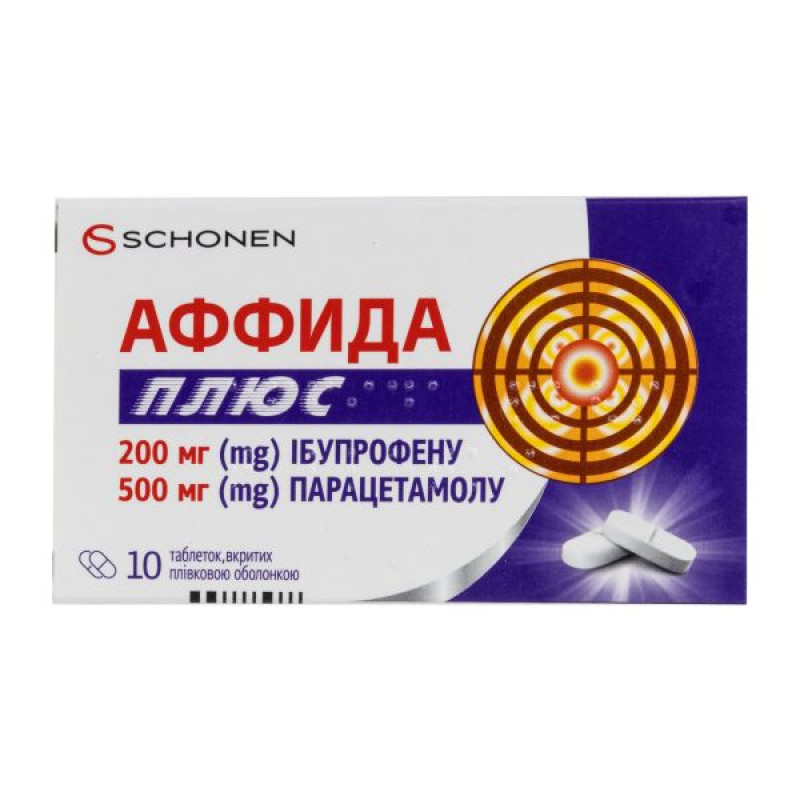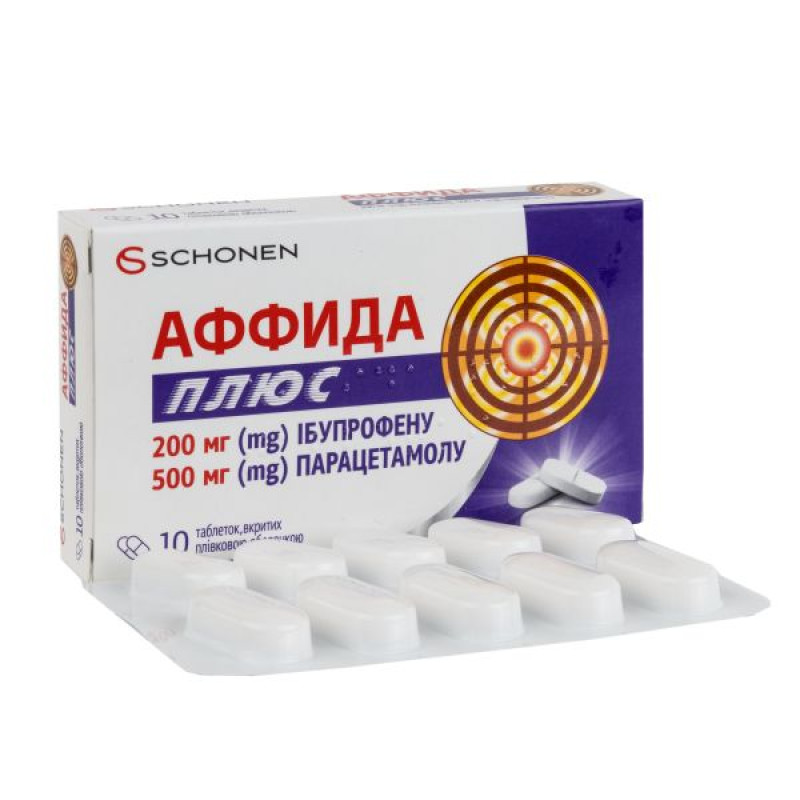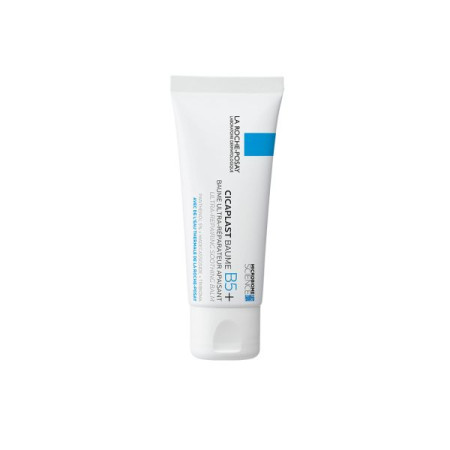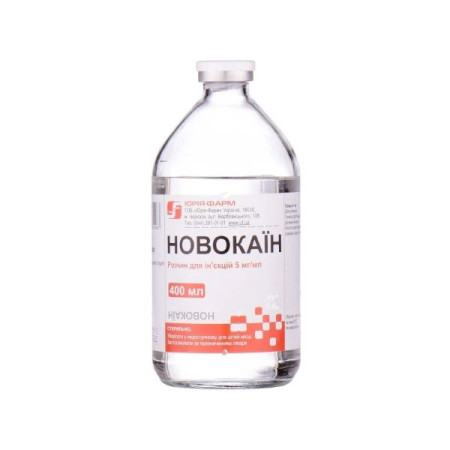Affida plus tablets 200 mg/500 mg No. 10

Instructions for Affida plus tablets 200 mg/500 mg No. 10
Composition
active ingredients: ibuprofen; paracetamol;
1 film-coated tablet contains 200 mg of ibuprofen and 500 mg of paracetamol;
excipients: corn starch, povidone (E 1201), croscarmellose sodium, microcrystalline cellulose (E 460), colloidal anhydrous silica, glycerol dibehenate; Opadry White AMB II (polyvinyl alcohol, partially hydrolyzed; talc; titanium dioxide (E 171); glycerol monocaprylocaprate; sodium lauryl sulfate).
Dosage form
Film-coated tablets.
Main physicochemical properties: white or almost white biconvex, oval-shaped tablets, film-coated, marked with a double circle on one side.
Pharmacotherapeutic group
Preparations for the treatment of the musculoskeletal system, anti-inflammatory and antirheumatic drugs, non-steroidal drugs, propionic acid derivatives. Ibuprofen, combinations.
ATX code M01A E51.
Pharmacological properties
Pharmacodynamics
The pharmacological action of ibuprofen and paracetamol differs in site and mode of action, but is synergistic, leading to increased analgesic and antipyretic properties compared to those when each substance is used separately.
Ibuprofen is a nonsteroidal anti-inflammatory drug (NSAID), a propionic acid derivative, which has demonstrated its effectiveness in inhibiting the synthesis of prostaglandins - mediators of pain and inflammation. Ibuprofen has analgesic, antipyretic and anti-inflammatory effects. In addition, ibuprofen reversibly inhibits platelet aggregation.
Experimental data suggest that ibuprofen may competitively inhibit the effect of low-dose acetylsalicylic acid on platelet aggregation when these drugs are used concomitantly. Some pharmacodynamic studies have shown that single doses of ibuprofen 400 mg administered within 8 hours before or within 30 minutes after immediate-release acetylsalicylic acid (81 mg) have been shown to reduce the effect of aspirin/acetylsalicylic acid on thromboxane formation or platelet aggregation. Although there is uncertainty about the extrapolation of these data to the clinical situation, it cannot be excluded that regular long-term use of ibuprofen may reduce the cardioprotective effect of low-dose acetylsalicylic acid. Such a clinically significant effect is considered unlikely with non-systematic use of ibuprofen.
The mechanism of action of paracetamol is still not fully understood; however, there is convincing evidence of an analgesic effect on the central nervous system. Biochemical studies indicate inhibition of COX-2 activity in the CNS. Paracetamol can also stimulate descending pathways of activation of 5-hydroxytryptamine (serotonin), which inhibits the transmission of pain signals in the spinal cord.
The drug is particularly suitable for the treatment of pain that requires a stronger analgesic effect than ibuprofen 400 mg or paracetamol 1000 mg alone.
Studies using this combination on a model of acute pain (postoperative dental pain) and chronic knee pain have shown high efficacy of this combination in reducing the severity of acute pain (93.2%) and long-term treatment of chronic pain.
(60.2%). This drug has a rapid onset of action with a confirmed significant reduction in pain, which is noted on average after 18.3 minutes. Significant pain relief is noted on average after 44.6 minutes. The analgesic effect of this drug is significantly longer (9.1 hours) than that of paracetamol 500 mg (4 hours).
Pharmacokinetics
Ibuprofen is rapidly absorbed from the gastrointestinal tract and is extensively bound to plasma proteins. Ibuprofen is detected in plasma within 5 minutes, reaching peak concentrations 1–2 hours after administration on an empty stomach. Ibuprofen is metabolized in the liver and excreted by the kidneys. The half-life is approximately 2 hours.
Paracetamol is rapidly absorbed from the gastrointestinal tract. At therapeutic concentrations, the level of binding to plasma proteins is low, although it depends on the dose. Paracetamol in the blood plasma is determined after 5 minutes, reaching a maximum concentration after 0.5–0.67 hours after administration in the fasting state.
Paracetamol is metabolized in the liver and excreted in the urine mainly as conjugates. Less than 5% of paracetamol is excreted unchanged. The hydroxylated metabolite, which is formed in very small quantities in the liver under the influence of mixed oxidases and is detoxified by binding to hepatic glutathione, can accumulate in case of paracetamol overdose and cause liver tissue damage. The half-life is approximately 3 hours. No significant difference in the pharmacokinetic profile of paracetamol and ibuprofen in elderly patients has been found. The bioavailability and pharmacokinetic profile of ibuprofen and paracetamol in this preparation do not change when taking a single or repeated dose of such a combination.
The composition of this drug is developed using technology that ensures the simultaneous release of ibuprofen and paracetamol in such a way as to potentiate the effects of each of the active ingredients.
Indication
Symptomatic treatment of mild to moderate pain in migraine, headache, backache, menstrual pain, toothache, rheumatic and muscular pain, pain in mild forms of arthritis, symptoms of colds and flu, sore throat and fever. This medicine is particularly suitable for the treatment of pain that requires a stronger analgesic effect than that of ibuprofen or paracetamol used alone.
Contraindication
This drug is contraindicated:
· patients with known individual hypersensitivity to ibuprofen, paracetamol or any of the excipients;
· when used simultaneously with other drugs containing paracetamol, due to an increased risk of serious adverse reactions;
· patients with a history of hypersensitivity reactions (e.g. bronchospasm, angioedema, bronchial asthma, rhinitis or urticaria) after taking ibuprofen, acetylsalicylic acid or other non-steroidal anti-inflammatory drugs (NSAIDs);
· patients with a history of gastrointestinal bleeding or perforation associated with the use of NSAIDs;
· with gastric and duodenal ulcer/bleeding in active form or history of relapses (two or more severe episodes of ulcer or bleeding);
· patients with blood clotting disorders;
· patients with severe hepatic, severe renal or severe heart failure (NYHA class IV);
· with simultaneous use of other drugs containing NSAIDs, including cyclooxygenase-2 (COX-2) inhibitors and acetylsalicylic acid in a daily dose of more than 75 mg, due to an increased risk of adverse reactions;
· during the last trimester of pregnancy due to the risk of premature closure of the fetal ductus arteriosus with possible pulmonary hypertension.
Interaction with other medicinal products and other types of interactions
This medicinal product (as well as any other paracetamol-containing products) is contraindicated when used with other paracetamol-containing products due to an increased risk of serious adverse reactions (see section "Contraindications").
This drug (like other ibuprofen-containing drugs and NSAIDs) should not be used in combination with:
- aspirin (acetylsalicylic acid), as this may increase the risk of adverse reactions, unless aspirin (dose not exceeding 75 mg per day) has been prescribed by a doctor. Experimental data suggest that ibuprofen may inhibit the effect of low-dose acetylsalicylic acid (aspirin) on platelet aggregation when used concomitantly. However, the possibility of extrapolating these data to the clinical situation is limited, so there is no definitive conclusion that regular long-term use of ibuprofen may reduce the cardioprotective effect of low-dose acetylsalicylic acid. With non-systematic use of ibuprofen, such clinically significant effects are considered unlikely;
- other NSAIDs, including selective COX-2 inhibitors, as this may lead to an increased incidence of adverse reactions (see section "Contraindications").
This drug (as well as other paracetamol-containing products) should be used with caution in combination with the following drugs:
- chloramphenicol: increased concentration of chloramphenicol in blood plasma;
- cholestyramine: the rate of absorption of paracetamol is reduced by cholestyramine, therefore paracetamol should be administered 1 hour before cholestyramine if maximum analgesia is required;
- metoclopramide and domperidone: paracetamol absorption is increased by metoclopramide and domperidone, but they can be used simultaneously;
- Warfarin: the anticoagulant effect of warfarin and other coumarins may be enhanced by long-term regular use of paracetamol with an increased risk of bleeding; occasional use has no significant effect.
This drug (as well as other ibuprofen-containing products and NSAIDs) should be used with caution in combination with the following drugs.
Anticoagulants. NSAIDs may increase the therapeutic effect of anticoagulants such as warfarin. The anticoagulant effect of warfarin and other coumarins may be enhanced by prolonged regular daily use of paracetamol, with an increased risk of bleeding.
Antihypertensives and diuretics. Nonsteroidal anti-inflammatory drugs may reduce the therapeutic effect of these drugs and increase the risk of nephrotoxicity. In some patients with impaired renal function (e.g. dehydrated patients or elderly patients with compromised renal function), the concomitant use of an ACE inhibitor or angiotensin II antagonist and drugs that inhibit cyclooxygenase may lead to further deterioration of renal function, in particular possible acute renal failure, which is usually reversible. Therefore, such combinations should be prescribed with caution, especially in elderly patients. If long-term treatment is necessary, the patient should be adequately hydrated and consideration should be given to monitoring renal function at the beginning of the combination treatment and periodically thereafter. Diuretics may increase the risk of nephrotoxicity of NSAIDs.
Acetylsalicylic acid. Experimental data suggest that ibuprofen may competitively inhibit the effect of low-dose acetylsalicylic acid on platelet aggregation when these drugs are used concomitantly. However, the limitations in extrapolating these data to the clinical situation prevent definitive conclusions that regular long-term use of ibuprofen may reduce the cardioprotective effect of low-dose acetylsalicylic acid. It is considered that irregular use of ibuprofen is unlikely to have any clinically significant consequences.
Cardiac glycosides. NSAIDs increase the level of glycosides in the blood plasma, can aggravate cardiac dysfunction, and reduce the glomerular filtration function of the kidneys.
Cyclosporine: Possible increased risk of nephrotoxicity.
Corticosteroids may increase the risk of adverse reactions in the digestive tract (gastrointestinal ulcers or bleeding).
Lithium and methotrexate: There is evidence of a potential increase in plasma levels of lithium and methotrexate.
Diuretics: Reduced therapeutic effect of diuretics. Diuretics may increase the risk of nephrotoxicity of NSAIDs.
Mifepristone: NSAIDs should not be used earlier than 8-12 days after mifepristone administration, as they reduce its effectiveness.
Quinolone antibiotics: Animal studies suggest that NSAIDs may increase the risk of seizures associated with the use of quinoline antibiotics. The risk of seizures is increased when NSAIDs and quinolones are used concomitantly.
Tacrolimus: There may be an increased risk of nephrotoxicity with concomitant use of NSAIDs and tacrolimus.
Zidovudine: Increased risk of hematological toxicity with concomitant use of zidovudine and NSAIDs. There is evidence of an increased risk of hemarthrosis and hematoma in HIV-infected patients with hemophilia when zidovudine is co-administered with ibuprofen.
Antiemetics: The rate of absorption of paracetamol may be increased by metoclopramide or domperidone.
Application features
The risk of paracetamol overdose is higher in patients with alcoholic liver disease without symptoms of cirrhosis. In case of overdose, immediate medical attention should be sought, even if the patient feels well, as there is a risk of delayed serious liver damage.
To reduce the risk of adverse reactions, the lowest effective dose should be used for the shortest period necessary to relieve symptoms and the drug should be taken with food.
Paracetamol.
Paracetamol should be administered with caution to patients with severe renal and hepatic impairment. The risk of paracetamol overdose is higher in patients with non-cirrhotic alcoholic liver disease. In case of overdose, seek medical attention immediately, even if the patient feels well, because of the risk of delayed serious liver damage.
Do not take other medicines containing paracetamol. If this happens, you should contact your doctor immediately, even if you feel well, as this may lead to an overdose.
Ibuprofen.
Undesirable effects can be minimized by using the lowest effective dose necessary to relieve symptoms, for the shortest period of time necessary to eliminate symptoms, and with food.
Elderly patients.
Elderly patients are more likely to experience adverse reactions to NSAIDs, especially gastrointestinal bleeding or perforation, which can be fatal. If NSAIDs are necessary, the lowest effective dose should be used for the shortest duration possible.
The patient should be regularly monitored for the possibility of gastrointestinal bleeding during NSAID therapy.
Effects on the respiratory system.
Bronchospasm may occur in patients who suffer from bronchial asthma or allergic diseases after using nonsteroidal anti-inflammatory drugs or have a history of these diseases.
Effects on the cardiovascular and cerebrovascular systems.
Patients with a history of hypertension and/or heart failure should be treated with caution (consultation with a doctor is necessary), since cases of fluid retention, hypertension and edema have been reported with ibuprofen therapy, as with other NSAIDs.
Patients with uncontrolled hypertension, congestive heart failure (NYHA class II-III), established ischemic heart disease, peripheral arterial disease and/or cerebrovascular disease should be treated with ibuprofen only after careful clinical assessment. High doses (2400 mg/day) should be avoided. The clinical assessment should also be carefully considered before initiating long-term treatment in patients with risk factors for cardiovascular complications (such as hypertension, hyperlipidemia, diabetes mellitus, smoking), especially if high doses of ibuprofen (2400 mg/day) are required.
Cardiovascular, hepatic and renal failure.
NSAIDs may cause a dose-dependent decrease in prostaglandin formation and the development of renal failure. Patients with impaired renal function, cardiac dysfunction, hepatic dysfunction, patients taking diuretics and elderly patients are at increased risk. In such patients, renal function should be monitored.
Effect on the gastrointestinal system.
Nonsteroidal anti-inflammatory drugs should be prescribed with caution to patients with a history of gastrointestinal disorders (ulcerative colitis and Crohn's disease), as these conditions may be exacerbated.
Cases of gastrointestinal bleeding, perforation, and ulceration, which can be fatal, have been reported at any stage of NSAID treatment, regardless of the presence of alarm symptoms or a history of severe gastrointestinal disorders.
The risk of gastrointestinal bleeding, ulceration or perforation increases with increasing NSAID dose, with a history of ulcer, especially ulcer complicated by bleeding or perforation, and in elderly patients. In these patients, treatment should be initiated at the lowest effective dose. Combination therapy with protective agents (e.g. misoprostol or proton pump inhibitors) should be considered for these patients, as well as for patients who require concomitant low-dose acetylsalicylic acid or other drugs that may increase the gastrointestinal risk.
Patients with a history of gastrointestinal disorders, especially elderly patients, should be informed of any adverse gastrointestinal symptoms (especially bleeding), particularly at the beginning of treatment.
The drug should be prescribed with caution to patients receiving concomitant medications that may increase the risk of ulceration or bleeding, such as oral corticosteroids, anticoagulants such as warfarin, selective serotonin reuptake inhibitors (SSRIs), or antiplatelet drugs such as aspirin.
The occurrence of gastrointestinal bleeding or ulceration in patients receiving ibuprofen-containing drugs requires immediate discontinuation of treatment with this drug.
Systemic lupus erythematosus and mixed connective tissue disease.
Patients with systemic lupus erythematosus and mixed connective tissue disease may be at increased risk of developing aseptic meningitis.
Severe skin reactions.
Rare serious skin reactions, which can be fatal, including exfoliative dermatitis, Stevens-Johnson syndrome and toxic epidermal necrolysis, have been reported in association with the use of non-steroidal anti-inflammatory drugs (NSAIDs) (see section 4.8).
The risk of these reactions is high at the beginning of therapy. The onset of the reaction occurs in most cases within the first month of treatment. A case of acute generalized exanthematous pustulosis has also been reported after the use of ibuprofen-containing medicinal products.
Ibuprofen should be discontinued at the first signs and symptoms of skin lesions, such as skin rashes, mucosal lesions, or any other signs of hypersensitivity.
Impact on fertility in women.
There is limited evidence that drugs that inhibit cyclooxygenase/prostaglandin synthesis may affect ovulation. This process is reversible after discontinuation of treatment. Women who have problems conceiving or who are being investigated for infertility should refrain from using the drug.
Masking the symptoms of underlying infections.
Ibuprofen may mask the symptoms of an infectious disease, which may delay the initiation of appropriate treatment and thus complicate the course of the disease. This has been observed in bacterial community-acquired pneumonia and bacterial complications of varicella. When ibuprofen is used for fever or for pain relief in an infection, monitoring for the presence of an infectious disease is recommended. In the setting of treatment outside a medical facility, the patient should consult a doctor if symptoms persist or worsen.
Important information about excipients.
This medicine contains less than 1 mmol sodium (23 mg) per tablet, that is to say essentially sodium-free.
Use during pregnancy or breastfeeding
Pregnancy
A large amount of data on pregnant women indicate neither malformative nor feto/neonatal toxicity. Epidemiological studies on the development of the nervous system in children exposed to paracetamol in utero are inconclusive. If clinically necessary, paracetamol can be used during pregnancy, but it should be used at the lowest effective dose for the shortest duration and with the least possible frequency.
Congenital anomalies have been reported following the use of NSAIDs in humans; however, they are of low frequency and generally do not show any discernible pattern. Given the known effects of NSAIDs on the fetal cardiovascular system (risk of premature closure of the ductus arteriosus), use in the third trimester is contraindicated. Delayed or prolonged labor may occur, with increased bleeding tendency in both mother and child.
The drug should be avoided during the first and second trimesters of pregnancy, as well as during childbirth; the drug is contraindicated in the third trimester of pregnancy.
Breastfeeding period
Ibuprofen and its metabolites may pass into breast milk in very low concentrations (0.0008% of the maternal dose). Harmful effects on infants are unknown.
Paracetamol passes into breast milk, but in clinically insignificant quantities. Available published data do not rule out the possibility of taking the drug during breastfeeding.
Therefore, there is no need to discontinue breastfeeding during short-term therapy with this drug at recommended doses.
Ability to influence reaction speed when driving vehicles or other mechanisms
Side effects such as dizziness, drowsiness, fatigue, and visual disturbances are possible after taking NSAIDs. Patients who experience these side effects should not drive or operate machinery.
Method of administration and doses
For oral short-term use only.
The lowest effective dose should be used for the shortest time necessary to relieve symptoms (see section "Special instructions").
If the symptoms of the disease persist for more than 3 days, it is necessary to consult a doctor to clarify the diagnosis and adjust the treatment regimen. The duration of treatment is determined by the doctor individually, depending on the course of the disease and the patient's condition.
Adults should take 1 tablet up to 3 times a day with an interval of at least 6 hours between doses. Swallow the tablets with water.
If 1 tablet does not relieve the symptoms of the disease, 2 tablets should be taken at a time, but not more than 3 times a day. The interval between doses should be at least 6 hours. Do not take more than 6 tablets (3000 mg of paracetamol, 1200 mg of ibuprofen) within 24 hours.
To minimize the likelihood of side effects, take the drug with meals.
Elderly patients.
Do not require dosage adjustment.
Because of the potential for adverse effects, elderly patients should be monitored particularly closely. If NSAIDs are necessary, the lowest effective dose should be used for the shortest possible time. The patient should be monitored regularly for gastrointestinal bleeding during NSAID therapy.
Children: Do not use in children (under 18 years of age).
Overdose
Paracetamol.
Liver damage is possible in adults who have taken 10 g (equivalent to 20 tablets) or more of paracetamol. Taking 5 g (equivalent to 10 tablets) or more of paracetamol can lead to liver damage if:
- the patient is receiving long-term treatment with carbamazepine, phenobarbitone, phenytoin, primidone, rifampicin, St. John's wort, or drugs that induce liver enzymes.
- the patient regularly consumes alcohol;
- the patient is likely to have a glutathione deficiency, for example, has fibrocystic degeneration,
HIV infection, cachexia or starvation.
Symptoms: Symptoms of paracetamol overdose within the first 24 hours include pallor, nausea, vomiting, food aversion and abdominal pain. Liver damage may manifest as
12 - 48 hours after overdose, manifested by abnormal liver function tests. Glucose metabolism disorders and metabolic acidosis may occur. In severe poisoning, hepatic failure may progress to encephalopathy, hemorrhage, hypoglycemia, coma, and be fatal. Acute renal failure with acute tubular necrosis may present with severe lumbar pain, hematuria, and proteinuria and may develop even in the absence of severe liver damage. Cardiac arrhythmias and pancreatitis have also been reported.
Treatment. Paracetamol overdose requires immediate medical attention. The patient should be taken to hospital for medical examination immediately, even if there are no early symptoms of overdose. Symptoms may be limited to nausea and vomiting and may not reflect the severity of the overdose or the risk of organ damage. Treatment should be carried out in accordance with established treatment guidelines.
Treatment with N-acetylcysteine can be given within 24 hours of paracetamol ingestion, but the maximum protective effect is obtained when it is administered within 8 hours of taking an overdose of the drug. The effectiveness of the antidote decreases sharply after this time.
If necessary, the patient should be given intravenous N-acetylcysteine according to the established dose schedule. In the absence of vomiting, oral methionine may be used as a suitable alternative in remote areas outside the hospital.
Treatment of patients who develop severe liver dysfunction within 24 hours of taking paracetamol should be carried out in accordance with established recommendations.
Ibuprofen.
The use of ibuprofen in doses exceeding 400 mg/kg in children may cause symptoms of overdose. In adults, the dose-dependent effect is less pronounced. The half-life in overdose is 1.5 - 3 hours.
Symptoms. Most patients who have taken clinically significant amounts of NSAIDs may experience only nausea, vomiting, epigastric pain or, very rarely, diarrhoea. Tinnitus, headache and gastrointestinal bleeding may also occur. In more severe poisoning, toxic effects on the central nervous system may occur, manifested by drowsiness, sometimes by nervous excitement and disorientation or coma. Sometimes patients experience convulsions. In severe poisoning, metabolic acidosis may develop; the prothrombin index/international normalized ratio (INR) may be elevated, presumably due to effects on blood clotting factors. Acute renal failure and liver damage may occur in the presence of dehydration. In patients with bronchial asthma, exacerbation of the disease is possible.
Treatment. Treatment should be symptomatic and supportive, and include maintaining a patent airway and monitoring cardiac symptoms and vital signs until the condition returns to normal. Oral administration of activated charcoal is recommended within 1 hour of ingestion of a potentially toxic amount. Diazepam or lorazepam should be administered intravenously for frequent or prolonged seizures. Bronchodilators should be used for the treatment of bronchial asthma.
Adverse reactions
The results of clinical studies conducted with this drug do not indicate the presence of any other adverse reactions than those observed with the use of ibuprofen or paracetamol separately.
The following are adverse reactions observed in patients taking ibuprofen or paracetamol alone during short-term and long-term use.
Frequency is defined as follows: very common (≥1/10), common (≥1/100 to
| Organ system class | Frequency | Adverse reaction | ||
| Blood and lymphatic system disorders | Very rare | Disorders of the hematopoietic system1. | ||
| On the part of the immune system | Infrequently | Hypersensitivity reactions including urticaria and pruritus2. | ||
| Very rare | Severe hypersensitivity reactions. Symptoms may include swelling of the face, tongue and larynx, shortness of breath, tachycardia, hypotension (anaphylaxis, angioedema or severe shock)2. | |||
| Mental disorders | Very rare | Confusion, depression, and hallucinations. | ||
| From the nervous system | Infrequently | Headache and dizziness. | ||
| Very rare | Aseptic meningitis3, paraesthesia, optic neuritis and somnolence. | |||
| From the organs of vision | Very rare | Visual impairment. | ||
| Hearing and balance disorders | Very rare | Tinnitus and vertigo. | ||
| From the heart | Very rare | Heart failure and edema4. | ||
| From the vascular side | Very rare | Hypertension4. | ||
| Respiratory and mediastinal disorders | Very rare | Respiratory sensitivity, including asthma, asthma exacerbation, bronchospasm and dyspnea2. | ||
| Gastrointestinal tract | Often | Abdominal pain, vomiting, diarrhea, nausea, dyspepsia and gastrointestinal discomfort5. | ||
| Infrequently | Peptic ulcer, gastrointestinal perforation or gastrointestinal bleeding, melena, haematemesis6, mouth ulcers, exacerbation of colitis and Crohn's disease7, gastritis, pancreatitis, flatulence and constipation. | |||
| Hepatobiliary system | Very rare | Liver dysfunction, hepatitis and jaundice8. | ||
| Skin and subcutaneous tissue disorders | Often | Increased sweating. | ||
| Infrequently | Various skin rashes2. | |||
| Very rare | Bullous reactions including Stevens-Johnson syndrome, erythema multiforme and toxic epidermal necrolysis2. Exfoliative dermatosis, purpura. | |||
| Drug reaction with eosinophilia and systemic symptoms (DRESS syndrome); acute generalized exanthematous pustulosis. Photosensitivity reactions. | ||||
| From the urinary system | Very rare | Various forms of nephrotoxicity, including interstitial nephritis, nephrotic syndrome, and acute or chronic renal failure9. | ||
| General disorders | Very rare | Fatigue and discomfort. | ||
| Laboratory studies | Often | Elevated alanine aminotransferase, increased gamma-glutamyltransferase, and worsening liver function tests caused by paracetamol use. Increased creatinine level, increased blood urea level. | ||
| Infrequently | Increased aspartate aminotransferase, increased blood alkaline phosphatase, increased blood creatine phosphokinase, decreased hemoglobin, and increased platelets. |
Description of selected adverse reactions
1Examples include agranulocytosis, anemia, aplastic anemia, hemolytic anemia, leukopenia, neutropenia, pancytopenia, and thrombocytopenia. Initial signs include fever, sore throat, mouth ulcers, flu-like symptoms, severe fatigue, unexplained bleeding, bruising, and nosebleeds.
2 Hypersensitivity reactions have been reported. These include (a) non-specific allergic reactions and anaphylaxis, (b) respiratory tract reactions including asthma, asthma exacerbation, bronchospasm or dyspnoea, or (c) various skin reactions including rash of various types, pruritus, urticaria, purpura, angioedema and, less commonly, exfoliative and bullous dermatoses (including epidermal necrolysis, Stevens-Johnson syndrome and erythema multiforme).
3The mechanism of pathogenesis of drug-induced aseptic meningitis is not fully understood. However, available data on aseptic meningitis associated with NSAIDs suggest a hypersensitivity reaction (with symptoms occurring during drug administration and resolving after drug withdrawal). In particular, isolated cases of symptoms of aseptic meningitis, such as neck stiffness, headache, nausea, vomiting, fever or disorientation, have been observed during treatment with ibuprofen in patients with pre-existing autoimmune disorders (such as systemic lupus erythematosus, mixed connective tissue disease) (see section 4.4).
4Clinical studies suggest that the use of ibuprofen, especially in high doses,
(2400 mg/day) may be associated with a small increased risk of arterial thrombotic events (e.g. myocardial infarction or stroke) (see section "Special warnings and precautions for use").
5The most common adverse events are gastrointestinal.
6Sometimes fatal, especially in the elderly.
7See section "Application features".
8In overdose, paracetamol may cause acute hepatic failure, hepatic insufficiency, hepatic necrosis and liver damage (see section “Overdose”).
9Especially with long-term use, associated with increased serum urea and edema. Also includes papillary necrosis.
Reporting of suspected adverse reactions
It is important to report possible adverse reactions after a medicinal product has been authorised. This allows for continuous monitoring of the benefit-risk balance of the medicinal product. Healthcare professionals should report any
There are no reviews for this product.
There are no reviews for this product, be the first to leave your review.
No questions about this product, be the first and ask your question.











